四年级英语下册第二单元
- 格式:doc
- 大小:81.50 KB
- 文档页数:11
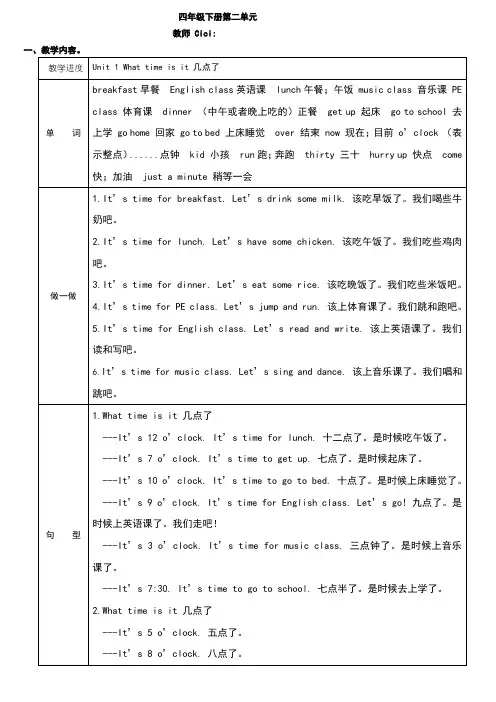
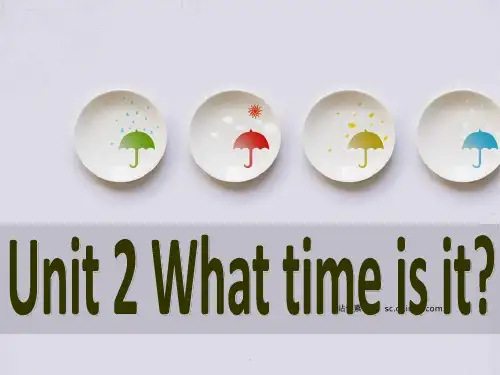
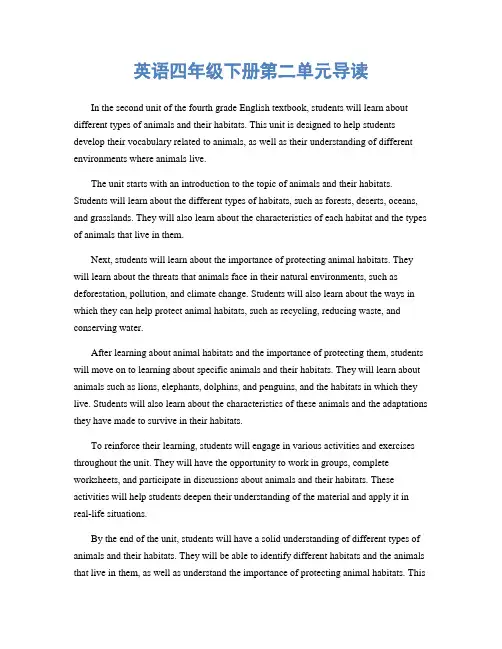
英语四年级下册第二单元导读In the second unit of the fourth grade English textbook, students will learn about different types of animals and their habitats. This unit is designed to help students develop their vocabulary related to animals, as well as their understanding of different environments where animals live.The unit starts with an introduction to the topic of animals and their habitats. Students will learn about the different types of habitats, such as forests, deserts, oceans, and grasslands. They will also learn about the characteristics of each habitat and the types of animals that live in them.Next, students will learn about the importance of protecting animal habitats. They will learn about the threats that animals face in their natural environments, such as deforestation, pollution, and climate change. Students will also learn about the ways in which they can help protect animal habitats, such as recycling, reducing waste, and conserving water.After learning about animal habitats and the importance of protecting them, students will move on to learning about specific animals and their habitats. They will learn about animals such as lions, elephants, dolphins, and penguins, and the habitats in which they live. Students will also learn about the characteristics of these animals and the adaptations they have made to survive in their habitats.To reinforce their learning, students will engage in various activities and exercises throughout the unit. They will have the opportunity to work in groups, complete worksheets, and participate in discussions about animals and their habitats. These activities will help students deepen their understanding of the material and apply it in real-life situations.By the end of the unit, students will have a solid understanding of different types of animals and their habitats. They will be able to identify different habitats and the animals that live in them, as well as understand the importance of protecting animal habitats. Thisunit will provide students with a strong foundation in environmental science and animal biology, setting them up for future learning in these areas.。

PEP(人教版)小学英语四年级下册,Unit,2,A,Lets,learn说课稿Unit 2 What time is it? A Let’s learn说课稿一、说教材 1、教材内容 PEP小学英语四年级下册Unit2 What time is it? (Part A Let’s learn ),本课时主要内容是学习时间的表达法以及不同时间进行的日常生活活动,需要掌握的词汇和句型分别是:music class,PE class, English class,breakfast,lunch,dinner,What time is it? It’s … It’s time for … 2、教材的地位本课是第二单元的第一课时,纵观PEP教材,本课时首次浮现了时间的表达法。
本课时又是第二单元的重点,因此本课时的教学对第二单元的学习起着决定性的作用。
二、说目标 1、教学目标根据教材的内容和大纲要求,我确定了以下教学目标: 知识目标能听、说、认读本课时的主要单词和词组以及句型。
能力目标能用本课时的句型描述、交流日常生活中的活动。
情感目标培养学生珍惜时间的品质和合理安排自己时间的习惯。
2、教学重难点重点:是听、说、认读本课时的单词和词组。
难点:是对新句型What time is it? It’s …It’s time for …的理解和运用。
三、说教法 1、教法设计“兴趣是最好的老师”,一个学生一旦对他所学的东西有强烈的兴趣,就会主动学习。
小学阶段是培养学生英语学习兴趣的关键时期,为此我主要采用直观教学、游戏教学、活动教学和多媒体辅助教学,激发学生学习英语的兴趣,培养学生综合运用英语的能力。
2、学法指导在本课教学中,我努力做到以课标为指导,以活动为方式,变课堂为乐园。
学生主要通过观察、摹仿、动手、表演、操练等方法,主动参预,乐于其中,无形中掌握知识、运用知识,形成终身学习必备的学习策略和能力。
农村小学学生的英语学习意识较淡薄,因此教学中我注意指导学生养成良好的学习英语的习惯,通过子细听音,观察老师的口形,认真摹仿,反复实践,正确发音,从而打下良好的语音语调基础。
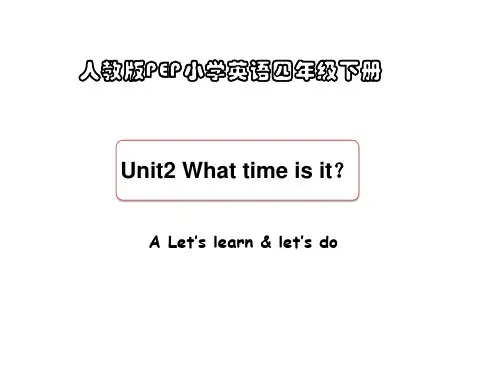
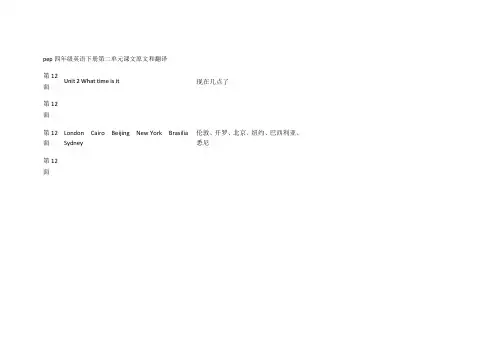
pep四年级英语下册第二单元课文原文和翻译第12面Unit 2 What time is it 现在几点了第12面第12面London Cairo Beijing New York BrasiliaSydney伦敦、开罗、北京、纽约、巴西利亚、悉尼第12面第12New York, 7 . 纽约。
早上七点。
面第12What time is it 几点了面第12It's 7 o'clock. 七点了。
面第12It's time to get up. 该起床了。
面第12面第12Brasilia, 9 . 巴西利亚,上午九点。
面第12What time is it 几点了面第12Hurry up! It's time for school! 快!该上学了!面第12面第12London, 12 noon 伦敦,中午十二点面第12What time is it 几点了面第12It's 12 o'clock. It's time for lunch. 十二点了。
该吃午饭了。
面第12面第12Cairo, 2 . 开罗,下午两点。
面第12What time is it 几点了面第12It's 2 o'clock. Let's play football. 两点了。
一起踢足球吧。
面第12OK. 好。
面第12面第12Beijing, 8 . 北京,晚上八点。
面第12What time is it 几点了面第12It's time to watch TV. 看电视的时间到了。
面第12面第12Sydney, 10 . 悉尼,晚上十点。
面第12What time is it 几点了面第12It's 10 o'clock. 十点了。
面第12It's time to go to bed. 该睡觉了。
面第12面第12面thirty forty fifty 30 40 50第12面ASIA ;AFRICA;EUROPE; ANTARCTICA;SOUTH AMERICA;NORTH AMERICA;亚洲;非洲;欧洲;南极洲;南美洲;北美洲第12面ATLANTIC OCEAN;ARCTICOCEAN;PACIFICOCEAN;INDIAN OCEAN大西洋北冰洋太平洋印度洋;第12面第12面第14面Unit 2 A Let's talk 一起说吧第14面第14Hi! School is over. Let's go to the playground.你好!放学了。

人教版四年级英语下册第二单元中文翻译Unit 2 第二单元What time is it? 现在几点钟?London, 12 noon 伦敦,中午十二点 Beijing, 8 p.m. 北京,晚上八点 Cairo, 2 p.m. 开罗,下午两点New York, 7 a.m. 纽约,早上七点 Brasilia, 9 a.m. 巴西,早上九点 Sydney, 10 p.m. 悉尼,晚上十点It's 12 o'clock. 现在是十二点。
It's time for lunch. 现在是吃午饭的时间。
It's time to watch TV. 到了看电视的时间了。
It's 2 o'clock. 现在是两点钟。
Let's play football. 我们踢足球吧。
OK. 好的。
What time is it? 现在几点钟?It's 7 o'clock. 现在是七点钟。
It's time to get up. 该起床了。
Hurry up! 快点!It's time for school! 该去上学了!It's 10 o'clock. 现在是十点钟。
It's time to go to bed. 该上床睡觉了。
A Let's talk 一起说一说Hi! School is over. 嗨!放学了。
Let's go to the playground. 我们去操场吧。
OK. 好的。
What time is it now? 现在几点钟?It's 5 o'clock. 现在五点钟。
Time to go home, kids. 孩子们,该回家了。
What time is it? 几点钟了?It's 6 o'clock. 六点了。
It's time for dinner. 该吃晚饭了。
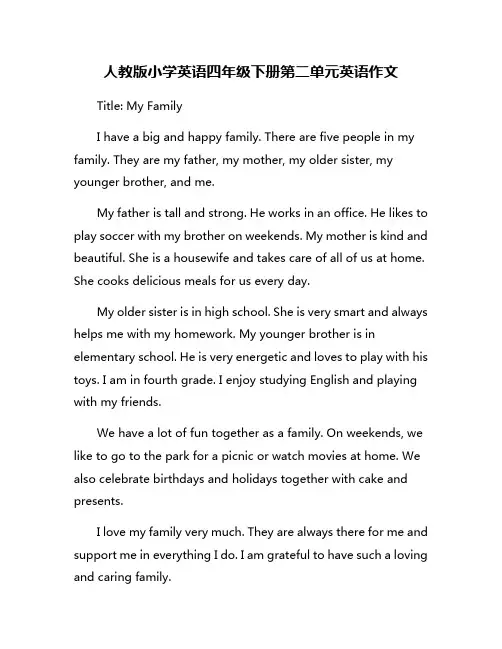
人教版小学英语四年级下册第二单元英语作文Title: My FamilyI have a big and happy family. There are five people in my family. They are my father, my mother, my older sister, my younger brother, and me.My father is tall and strong. He works in an office. He likes to play soccer with my brother on weekends. My mother is kind and beautiful. She is a housewife and takes care of all of us at home. She cooks delicious meals for us every day.My older sister is in high school. She is very smart and always helps me with my homework. My younger brother is in elementary school. He is very energetic and loves to play with his toys. I am in fourth grade. I enjoy studying English and playing with my friends.We have a lot of fun together as a family. On weekends, we like to go to the park for a picnic or watch movies at home. We also celebrate birthdays and holidays together with cake and presents.I love my family very much. They are always there for me and support me in everything I do. I am grateful to have such a loving and caring family.。
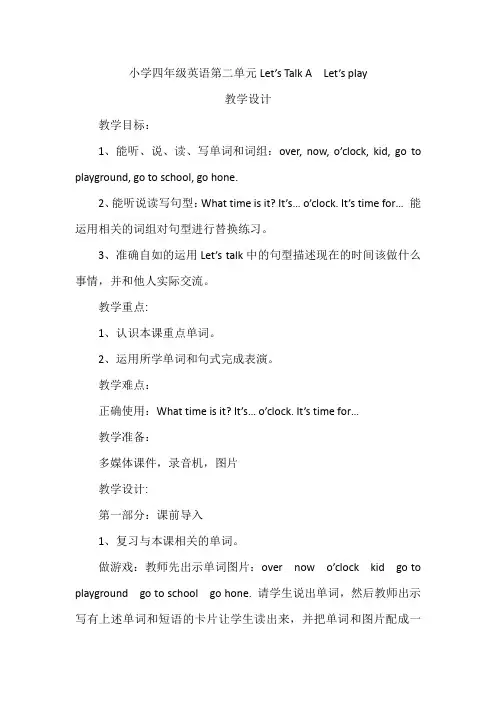
小学四年级英语第二单元Let’s Talk A Let’s play教学设计教学目标:1、能听、说、读、写单词和词组:over, now, o’clock, kid, go to playground, go to school, go hone.2、能听说读写句型:What time is it? It’s… o’clock. It’s time for…能运用相关的词组对句型进行替换练习。
3、准确自如的运用Let’s talk中的句型描述现在的时间该做什么事情,并和他人实际交流。
教学重点:1、认识本课重点单词。
2、运用所学单词和句式完成表演。
教学难点:正确使用:What time is it? It’s… o’clock. It’s time for…教学准备:多媒体课件,录音机,图片教学设计:第一部分:课前导入1、复习与本课相关的单词。
做游戏:教师先出示单词图片:over now o’clock kid go to playground go to school go hone. 请学生说出单词,然后教师出示写有上述单词和短语的卡片让学生读出来,并把单词和图片配成一对。
2、教师课件出示句子:What time is it? It's 7 o'clock, It's time to get up. It's 2 o'clock, Let's play football. It's10 o'clock, It's time to go to bed. Hurry up! It's time for school! 指名让学生朗读并理解意思,老师组织其他学生评价。
第二部分:探究学习Let’s Talk A1、教师课件出示自学问题设计,要求学生自学Let’s Talk A对话,并完成问题:what's means “School is over”?what's means “Time to go home”?what's means “It's time for dinner”?2、指名学生汇报,老师及其他学生倾听、评价。
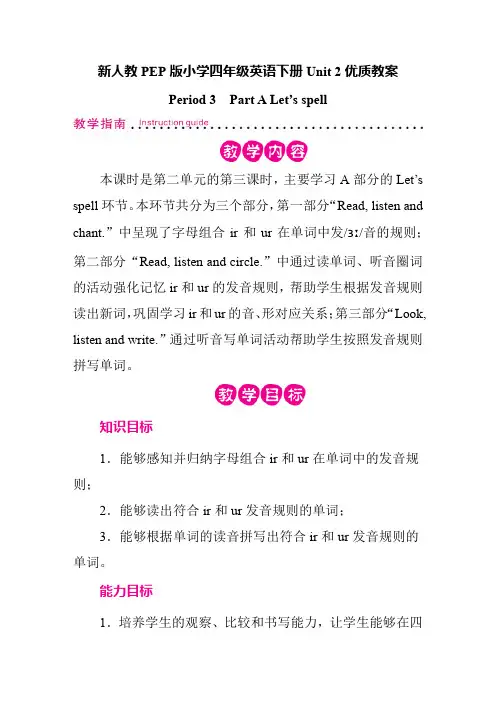
新人教PEP版小学四年级英语下册Unit 2优质教案Period 3Part A Let’s spell本课时是第二单元的第三课时,主要学习A部分的Let’s spell环节。
本环节共分为三个部分,第一部分“Read, listen and chant.”中呈现了字母组合ir和ur在单词中发/ɜː/音的规则;第二部分“Read, listen and circle.”中通过读单词、听音圈词的活动强化记忆ir和ur的发音规则,帮助学生根据发音规则读出新词,巩固学习ir和ur的音、形对应关系;第三部分“Look, listen and write.”通过听音写单词活动帮助学生按照发音规则拼写单词。
知识目标1.能够感知并归纳字母组合ir和ur在单词中的发音规则;2.能够读出符合ir和ur发音规则的单词;3.能够根据单词的读音拼写出符合ir和ur发音规则的单词。
能力目标1.培养学生的观察、比较和书写能力,让学生能够在四线三格中正确书写单词;2.培养学生通过语音规则记忆单词的能力。
情感目标帮助学生养成良好的拼读习惯和利用语音规则记忆单词的习惯。
教学重点1.掌握字母组合ir和ur在单词中的发音规则;2.能够读出符合ir和ur发音规则的单词。
通过拆音、拼音法,引导学生进行发现式学习,并通过观察、感知、体验等方式自主总结发音规则;教师讲解,学生反复练习拼读单词,让学生熟练朗读地本课时学习的单词,并试着自主拼读符合发音规律的生词。
教学难点1.能够准确读出字母组合ir和ur的发音;2.能够根据读音拼写出符合ir和ur发音规则的单词。
教师通过举例、对比等方法教读符合ir和ur发音规则的单词,加深学生的理解和记忆,并鼓励学生根据规则自主拼读和拼写单词。
多媒体课件、单词卡片。
Step 1:Warm-up1.教师与学生做上课时Let’s do的指令游戏。
教师说出指令句子,全班同学做动作。
2.教师利用多媒体课件呈现一些含字母组合er的单词(如:water,tiger,sister,computer,dinner等),让学生拼读,复习该字母组合的发音规则。
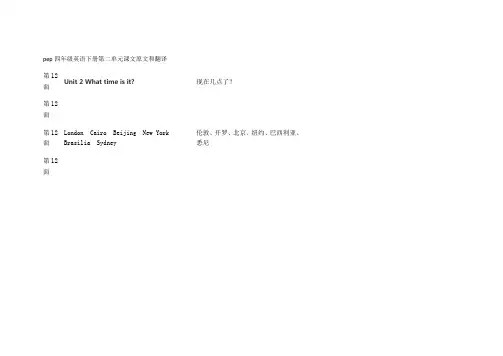
pep四年级英语下册第二单元课文原文和翻译第12面Unit 2 What time is it? 现在几点了?第12面第12面London Cairo Beijing New YorkBrasilia Sydney伦敦、开罗、北京、纽约、巴西利亚、悉尼第12面第12New York, 7 a.m. 纽约。
早上七点。
面第12What time is it? 几点了?面第12It's 7 o'clock. 七点了。
面第12It's time to get up. 该起床了。
面第12面第12Brasilia, 9 a.m. 巴西利亚,上午九点。
面第12What time is it? 几点了?面第12Hurry up! It's time for school! 快!该上学了!面第12面第12London, 12 noon 伦敦,中午十二点面第12What time is it? 几点了?面第12It's 12 o'clock. It's time for lunch. 十二点了。
该吃午饭了。
面第12面第12Cairo, 2 p.m. 开罗,下午两点。
面第12What time is it? 几点了?面第12It's 2 o'clock. Let's play football. 两点了。
一起踢足球吧。
面第12OK. 好。
面第12面第12Beijing, 8 p.m. 北京,晚上八点。
面第12What time is it? 几点了?面第12It's time to watch TV. 看电视的时间到了。
面第12面第12Sydney, 10 p.m. 悉尼,晚上十点。
面第12What time is it? 几点了?面第12It's 10 o'clock. 十点了。
面第12It's time to go to bed. 该睡觉了。
Pep四年级下册英语第二单元要点知识及练习一、词汇:一日三餐:breakfast早餐lunch午餐dinner/supper晚餐课程(classes):sports体育运动science科学Moral Education思想品德课Social Studies 社会课Chinese class语文math class数学PE class体育课English class英语课computer class 计算机课art class 美术课music class音乐课二、重点句型:1. (1)It’s time for +名词... 到...时间(2)It’s time to +动词... 是(该做).....的时候Eg:It’s time for English class. 到上英语课的时间了。
It’s time to go to school. 该上学了。
2.What time is it now? 现在几点钟了?It’s 5 o’clock. 5点了。
3.生活中常用的口语:School is over. 学校放学了。
Hurry up. 快点。
Just a minute.稍等一会儿。
Come on. 快点、加油。
Breakfast is ready. 早餐准备好了。
三、语音知识:“ir”--/ ɜː/第二单元单元练习及答案一、读单词,将画线部分读音相同的单词写在同一个房子里。
三、单项选择。
()1.—________is it?—It's 12 o'clock.A.What B.What time C.How many()2.It's time ________go to bed.A.to B.for C./()3.It's time ________lunch.A.to B.for C./()4.Sing and dance in a ________class.A.music B.math C.PE()5.School is over.Let's ________.A.go home B.go to bed C.go to school四、根据情境,选择正确的答案。
PEP人教版小学英语P E P人教版小学英语英语Unit 2 What time is it?Part A教学导航教学内容Let’s learn Let’s do Let’s talk Let’s spell教学目标【知识目标】能听、说、认读重点词汇breakfast,lunch,dinner,musicclass,PE class,English class。
【能力目标】能够在情境中运用句型“—What time is it?—It’s…”询问时间并作答。
【情感目标】培养学生严格的时间观念,养成守时守纪的好习惯。
教学重点 1.能听、说、认读本部分的重点词汇:breakfast,lunch,dinner,music class,PE class,English class。
2.能够在情境中运用句型“—What time is it?—It’s…It’stime for…”。
3.能用“It’s time for…”描述不同时间进行的活动。
4.能掌握字母组合ir与ur的发音规则。
教学难点会运用“What time is it?”询问时间并用句型“It’s…It’s教学过程第一课时breakfast.(边做喝牛奶的动作边引出单词)”3.同上引出重点词汇,播放录音让学生跟读单词。
4.以击鼓传笔的方式,教师有节奏地拍桌子,学生按顺序传笔,教师停,看笔落在谁的手里即选出单词带读。
5.在PPT上展示Let’s do部分的图片,教师用TPR方法展示动作,然后带领学生一起边做边说。
6.教师在黑板上画数个不同时间的钟,让学生两人一组自由对话,并且上台演示。
S1:What time is it?S2:It’s 6 o’clock.It’s time for dinner. 戏、TPR的方式让学生积极参与,寓教于乐。
作业设计1.抄写重点词汇breakfast,lunch,dinner,musicclass,PE class,English class。
英语四年级下册第二单元单词人教版四年级英语下册第二单元单词一、breakfast [ˈbrekfəst] n. 早餐;早饭1. 例句:I have breakfast at seven o'clock.(我在七点钟吃早饭。
)二、lunch [lʌntʃ] n. 午餐;午饭1. 例句:We have lunch at school.(我们在学校吃午饭。
)三、dinner [ˈdɪnə(r)] n. 晚餐;正餐(中午或晚上吃的)1. 例句:What do you have for dinner?(你晚餐吃什么?)四、English class [ˈɪŋɡlɪʃ klɑːs] 英语课1. 例句:We have an English class every day.(我们每天都有一节英语课。
)五、music class [ˈmjuːzɪk klɑːs] 音乐课1. 例句:I like music class very much.(我非常喜欢音乐课。
)六、PE class [ˌpiːˈiː klɑːs] 体育课1. 例句:We play basketball in PE class.(我们在体育课上打篮球。
)七、get up [ɡet ʌp] 起床1. 例句:I get up at six in the morning.(我早上六点起床。
)八、go to school [ɡəʊ tuː skuːl] 去上学1. 例句:I go to school by bike.(我骑自行车去上学。
)九、go home [ɡəʊ həʊm] 回家1. 例句:I go home at four o'clock.(我四点钟回家。
)十、go to bed [ɡəʊ tuː bed] 上床睡觉1. 例句:I go to bed at nine o'clock.(我九点钟上床睡觉。
)。
第一课时一、课时内容A. Let’s learn A. let’s do二、课时分析本课时是义务教育灵通版(pep)小学英语教科书四年级下册的第二单元第一课时,本课时围绕“时间”这个话题展开内容,包括 A. Let’s learn A. Let’s do 两个板块。
本课时的A Let’s learn.部分通过张鹏和John 讨论John 的一天来呈现有关课程和三餐的单词及词组的词形及意义。
A Let’s do 部分则是通过活动来操练A Let’s learn. 中的词汇及词组。
本活动训练孩子们手脑眼的配合,强烈训练单词的音义匹配,提高课堂的趣味性,从而培养学生惜时、守时的优秀品质。
培养学生按时作息的良好习惯。
三、课时目标1. 能够听、说、认、读A Let’s learn.部分关于课程和三餐的单词及词组:English class,music room,PE room,breakfast,lunch,dinner。
2. 能够熟练运用句型“What time is it ? It’s…o’clock.”来问答时间。
3. 能够运用It’s time for…来描述不同时间即将要做的活动。
4. 能够听懂指示语,并按照指令做出相应的动作。
5. 培养学生按时作息的良好习惯。
四、课时重难点1. 课时重点能够听、说、认、读关于课程和三餐的单词及词组:English class,music room,PE room,breakfast,lunch,dinner并能习得句子“What time is it ? It’s 9 o’clock.”来问答时间。
It’stime for English class.来描述不同时间即将要做的活动。
2. 课时难点正确使用句子:It’s time for …五、教学准备1. 本课时的单词卡片2. 教学挂图及配套PPT3. 录音机及配套磁带4. 自制小时钟5. 用作评价奖励的小礼物六、教学过程Step 1 Warm up师生问好,导入新课。
PEP 小学英语四年级下册Unit2教案Unit2 What time is it?Teaching Plan一、Teaching Topic:Time Subjects Meals二、Teaching aim:1.Grammar:Can understand and say What time is it?It‟s……It‟s time for…… It‟s time to……2.Lexis:lunch,dinner,breakfast,English class,music class,PE class,get up,go to school,go home,go to bed。
3.Can understand do and say some orders:Time for breakfast,Drinksome milk……4.Make a clock and to describe time5.Can set up timetable6.Know about story time and good to know, then talk about7.Develop the good habit of discipline punctuality三、Teaching point:Can apply comprehensively the knowledge they learnt四、Teaching materials:tape、word cards、clock、timetable、TV、computer五、Teaching time6 periodsThe 1st lesson:Let‟s sing,Let‟s learn,Let‟s do,Task time 1The 2nd lesson:Story time,Let‟s talk,Let‟s play Task time 1The 3rd lesson:Let‟s sing,Read and write,Good to knowThe 4th lesson:Let‟s learn,Let‟s chantThe 5th lesson:Let‟s check,Let‟s talkThe 6th lesson:Read and write,PronunciationThe 1st Lesson一、Teach aims:1.learn to listen,read and speak specific vocabulary:music class,PE class,English class,breakfast,lunch,dinner。
四年级下册英语二单元一、单词。
1. 早餐相关。
- breakfast(早餐),例如:I have breakfast at 7:00.(我在七点吃早餐。
)- egg(鸡蛋),复数形式是eggs,如:I like eggs for breakfast.(我早餐喜欢吃鸡蛋。
)- bread(面包),是不可数名词,例如:Some bread is on the table.(桌子上有一些面包。
)2. 时间相关。
- o'clock(……点钟),常和整点数字连用,如:It's six o'clock.(现在是六点钟。
)- class(课;班级),例如:We have an English class.(我们有一节英语课。
)- lunch(午餐),如:Lunch is at twelve.(午餐在十二点。
)- dinner(正餐;晚餐),例如:We have dinner at six thirty.(我们在六点半吃晚餐。
)3. 其他。
- English(英语;英国的),可以表示学科“英语”,也可表示国家相关的“英国的”,如:I like English.(我喜欢英语。
)This is an English book.(这是一本英语书。
)- music(音乐),例如:We have music class on Tuesday.(我们星期二有音乐课。
)- PE(体育),是physical education的缩写,如:We like PE class.(我们喜欢体育课。
)二、句型。
1. 询问时间。
- What time is it?(几点了?)- 回答:It's + 时间.例如:It's nine o'clock.(九点了。
)2. 描述三餐时间。
- It's time for + 三餐.(该吃……了。
)- 例如:It's time for breakfast.(该吃早餐了。